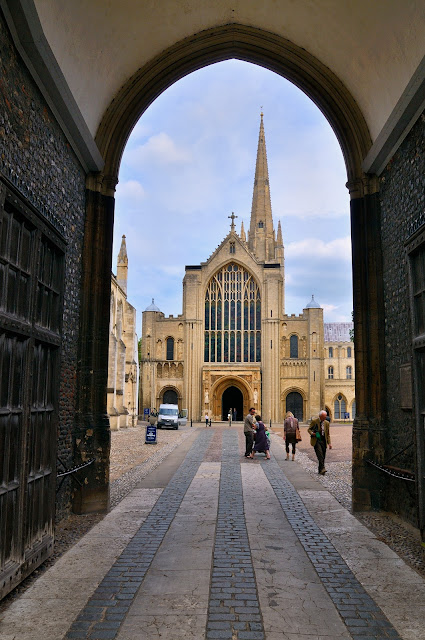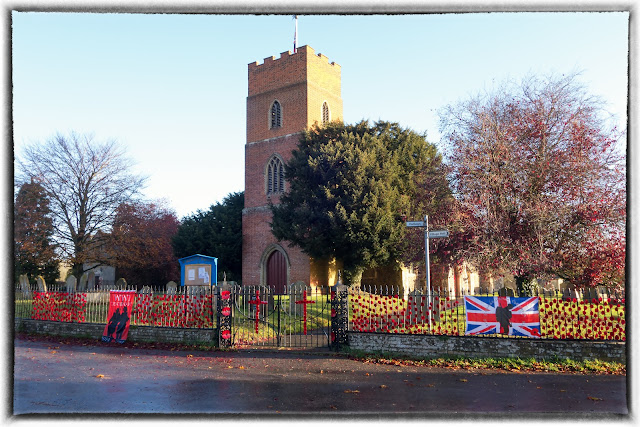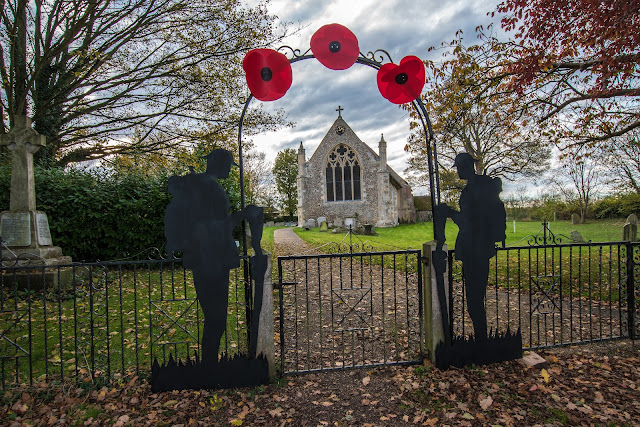Norwich Cathedral a seen through Erpingham Gate
Norwich Cathedral is dedicated to the Holy and Undivided Trinity. It is the cathedral church for the Church of England Diocese of Norwich. The cathedral was the vision of the 1st Bishop of Norwich, Herbert de Losinga in 1096 and took nearly 200 years to complete. The building itself is built in the shape of a cross and constructed out of light, smooth, Caen stone and grey, fossil filled stone from Northamptonshire.
The other, the Roman Catholic cathedral, is located on Unthank Road, and was constructed between 1882 and 1910 to designs by George Gilbert Scott, Jr. as a parish church dedicated to John the Baptist, on the site of the Norwich City Gaol. The funds for its construction were provided by Henry Fitzalan-Howard, 15th Duke of Norfolk. He funded it as a generous gift to the Catholics of Norwich as a sign of thanksgiving for his first marriage to Lady Flora Abney-Hastings.
In 1976, it was consecrated as the cathedral church for the newly erected Diocese of East Anglia and the seat of the Bishop of East Anglia. In 2014, for the first time since 1558, a Pontifical High Mass was celebrated in this episcopal see's cathedral.
Born in 1758, Nelson is a Norfolk born hero and his statue has him in the full-dress uniform of a Vice Admiral, accompanied by a telescope and a cannon to reinforce his stature. Nelson has been noted for his inspirational leadership style, and for his military strategy and unconventional tactics. Standing to the West of the Cathedral’s front entrance, he also looks towards Norwich School, where he was briefly a pupil.
Although he spent much of his life travelling the seas, leading the British Navy into numerous wars and victories, Nelson frequently returned to Norfolk and is quoted as saying ‘I am a Norfolk man, and Glory in being so.’
The Cloisters at Norwich Cathedral were built between 1297 and 1318. At 180 feet square, Norwich Cloisters come second only to Salisbury in size. The Monastery itself lay to the south of the Cathedral. The Monks spent most of their working lives here; there are alcoves where books would have been kept and also the original 'lavatorium' the washing area at the entrance to the Refectory. At that time washing was an important part of the Monastic ritual. Originally the Lavatorium consisted of two stories, with the Monks living in dormitories above. Around the Cloisters you can see more roof bosses at closer range; 100 of them alone depict the complete Book of Revelation.
Spire and south transept viewed from the cloisters
This memorial commemorates Arthur Wellesley, 1st Duke of Wellington, KG, GCB, GCH, PC, FRS (1769-1852). He was the British supreme commander during the Napoleonic Wars and became famous because of his victory in the Battle of Waterloo in 1815. Later he became prime minister of the United Kingdom.
Tombland, from the Old English meaning ‘empty space’, was also the site of a popular annual fair. Medieval fairs could get quite rowdy and the events often led to tensions between the monks of Norwich Priory and the townsfolk.
St Ethelbert’s gate is one of the two main gateways into cathedral close and it was built by the good citizens of Norwich as a penance for their unruly behaviour.
The story began in 1272 with a growing disagreement between religious men and the citizens of Norwich over rights, duties and boundaries – a number of citizens were even killed by the monks. The monks argued that as men of God they answered to their own justice system and did not abide by city laws. The monks locked the gates to the cathedral; instructing their men to attack anyone who got too close.
Things got even more heated, however, and the help hired by the murderous monks went on a rampage of violence that swept the city. The mob revolted and not only did they burn down the gates but also St Ethelbert’s church and damaged the cathedral and the cloisters during three days of rioting.
Once the rioting had been quelled, King Henry III himself came to Norwich and blamed the citizens for the damage - charging huge fines for repairs and rebuilding.
Even the Pope himself decreed that the entire city of Norwich was to be excommunicated from the church. Which says a lot about the secular justice system at the time and the status of the church.
The citizens were ordered to build a new entrance into the monastery area and hence - St Ethelbert’s Gate.
Norwich Castle was founded by William the Conqueror some time between 1066 and 1075. It originally took the form of a motte and bailey. Early in 1067, William the Conqueror embarked on a campaign to subjugate East Anglia, and according to military historian R. Allen Brown it was probably around this time that the castle was founded. It was first recorded in 1075, when Ralph de Gael, Earl of Norfolk, rebelled against William the Conqueror and Norwich was held by his men. A siege was undertaken, but ended when the garrison secured promises that they would not be harmed.
Norwich is one of 48 castles mentioned in the Domesday Survey of 1086. Building a castle in a pre-existing settlement necessitated the destruction of existing properties. Until the construction of Orford Castle in the mid-12th century under Henry II, Norwich was the only major royal castle in East Anglia.
The stone keep, which still stands today, was probably built between 1095 and 1110. In about the year 1100, the motte was made higher and the surrounding ditch deepened. During the Revolt of 1173–1174, in which Henry II's sons rebelled against him and started a civil war, Norwich Castle was put in a state of readiness. Hugh Bigod, 1st Earl of Norfolk was one of the more powerful earls who joined the revolt against Henry. With 318 Flemish soldiers that landed in England in May 1174, and 500 of his own men, Bigod advanced on Norwich Castle. They captured it and took fourteen prisoners who were held for ransom. When peace was restored later that year, Norwich was returned to royal control.
The Normans introduced the Jews to Norwich and they lived close to the castle. A cult was founded in Norwich in the wake of the murder of a young boy, William of Norwich, for which the Jews of the town were blamed. In Lent 1190, violence against Jews erupted in East Anglia and on 6 February (Shrove Tuesday) it spread to Norwich. Some fled to the safety of the castle, but those who did not were killed in their hundreds.
The castle was used as a prison for felons and debtors from 1220, with additional buildings constructed on the top of the motte next to the keep. The use of the castle as a gaol ended in 1887, when it was bought by the city of Norwich to be used as a museum.
The forebuilding attached to the keep was pulled down in 1825. Although the keep remains, its outer shell has been repaired repeatedly, most recently in 1835–9 by Anthony Salvin, with James Watson as mason using Bath stone. None of the inner or outer bailey buildings survive, and the original Norman bridge over the inner ditch was replaced in about the year 1825. During the renovation, the keep was completely refaced based faithfully on the original ornamentation.
The Saxon market was situated in Tombland, but after the Norman Conquest of 1066 a new market was established in the area known as 'Mancroft'.
By 1300 the main market in Mancroft stretched from Guildhall Hill almost to St Stephen's Church. Vegetables, fish, meat, bread, cloth, shoes, livestock and many other commodities were each sold in their proper place. A small area was kept for the use of smallholders who brought in produce from the county for sale on market days.
By the late seventeenth century the market was becoming so congested that a new site for livestock sales had to be found, and in 1738 the livestock market was moved to the 'castell dykes', below the castle mound. There it remained until 1960, when it was transferred to Harford Bridge.
The main market continued to flourish. At one end stood the meat and fish markets, separated by buildings from the rest of the area where not only vegetables, but also 'cloth, hats, shoes, stockings, rope, books, etc. were sold.
In the 1930s the whole market was remodelled to accommodate the City Hall, it was opened in 1938.
Norwich Market is unique in Britain. It boasts over 190 stalls and is the largest Monday-to-Saturday open market in the country - some say Europe!
St Peter Mancroft is a parish church in the Church of England, in the centre of Norwich, Norfolk. After the two cathedrals, it is the largest church in Norwich and was built between 1430 and 1455. It stands on a slightly elevated position, next to the market placeThe present building was begun in 1430, on the site of an existing church, and consecrated in 1455. It is an ambitious building, 180 feet long and ashlar faced with a tower at the west end. It is a Grade I listed building.
It has a Norman foundation dating from 1075, a 1463 font, a 1573 Flemish tapestry and medieval glass. The North transept displays a remarkable collection of church silver (one of the finest of any parish church in the country) including the Gleane and Thistle cups, as well as memorabilia associated with its most famous parishioner, the physician-philosopher Thomas Browne, author of Religio Medici (1642) The small lead-covered spire with flying buttresses was added by A.E. Street in 1896.
In 1850 two L-shaped trenches accommodating a number of acoustic jars were discovered beneath the wooden floor on which the choir stalls had previously stood. The earthenware jars were built into its walls at intervals of about three feet, with the mouths facing into the trenches.
The ancient medieval city of Norwich within the walls at one time had 36 parish churches, the largest collection of urban medieval buildings in any one city north of the Alps. Ten are still in use by the Church of England, while many are in use for other purposes.
Reflections in the Forum
The Forum is one of the most successful Millennium Projects in the UK. It opened in November 2001 and has become an iconic landmark and meeting place in the historic centre of Norwich.
It is a public building - everyone is welcome seven days a week all year round* - and the eclectic mix of free exhibitions, events, activities, catering, shopping and learning opportunities makes the Forum many things to many people.
Every day thousands of people come through the front doors to use the Norfolk and Norwich Millennium Library - the most popular public library in the UK. Many others come to The Forum to enjoy the free exhibitions and events in the huge Atrium, in the Gallery or on Millennium Plain, at the front of the building.
Café Bar Marzano, on the ground floor, is a popular and lively meeting place and Pizza Express, on mezzanine level, offers spectacular views over Millennium Plain and the city centre beyond.
The Forum is also the home of BBC East, which broadcasts daily TV and radio news across the Eastern Region, the Norwich Tourist Information Centre, the Forum Shop by Jarrold and MINT, a charity which helps young people find employment.
I do need to get a good photo though!
Elm Hill - one of the beautiful cobbled streets in Norwich, once home to many wealthy merchants.




















































